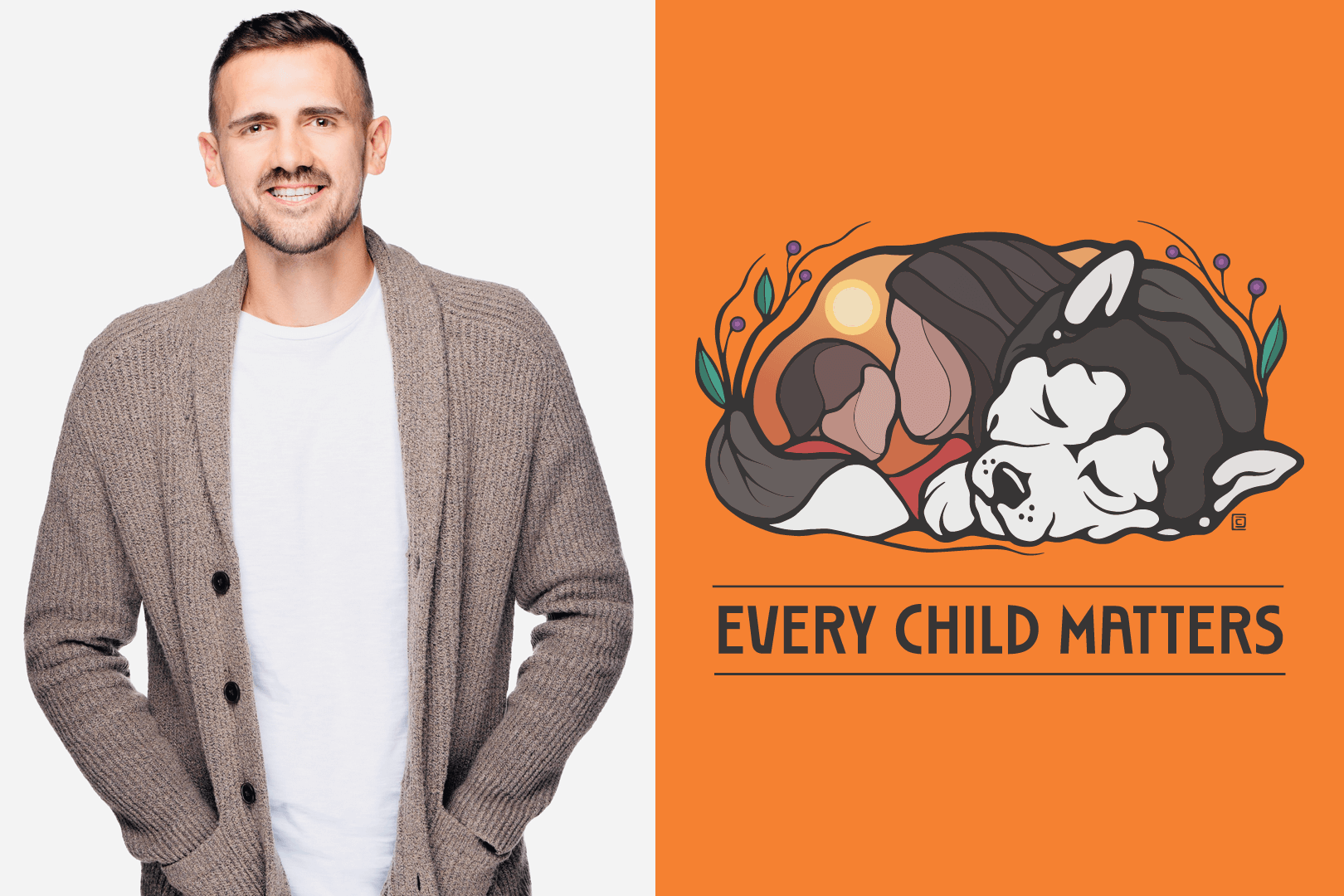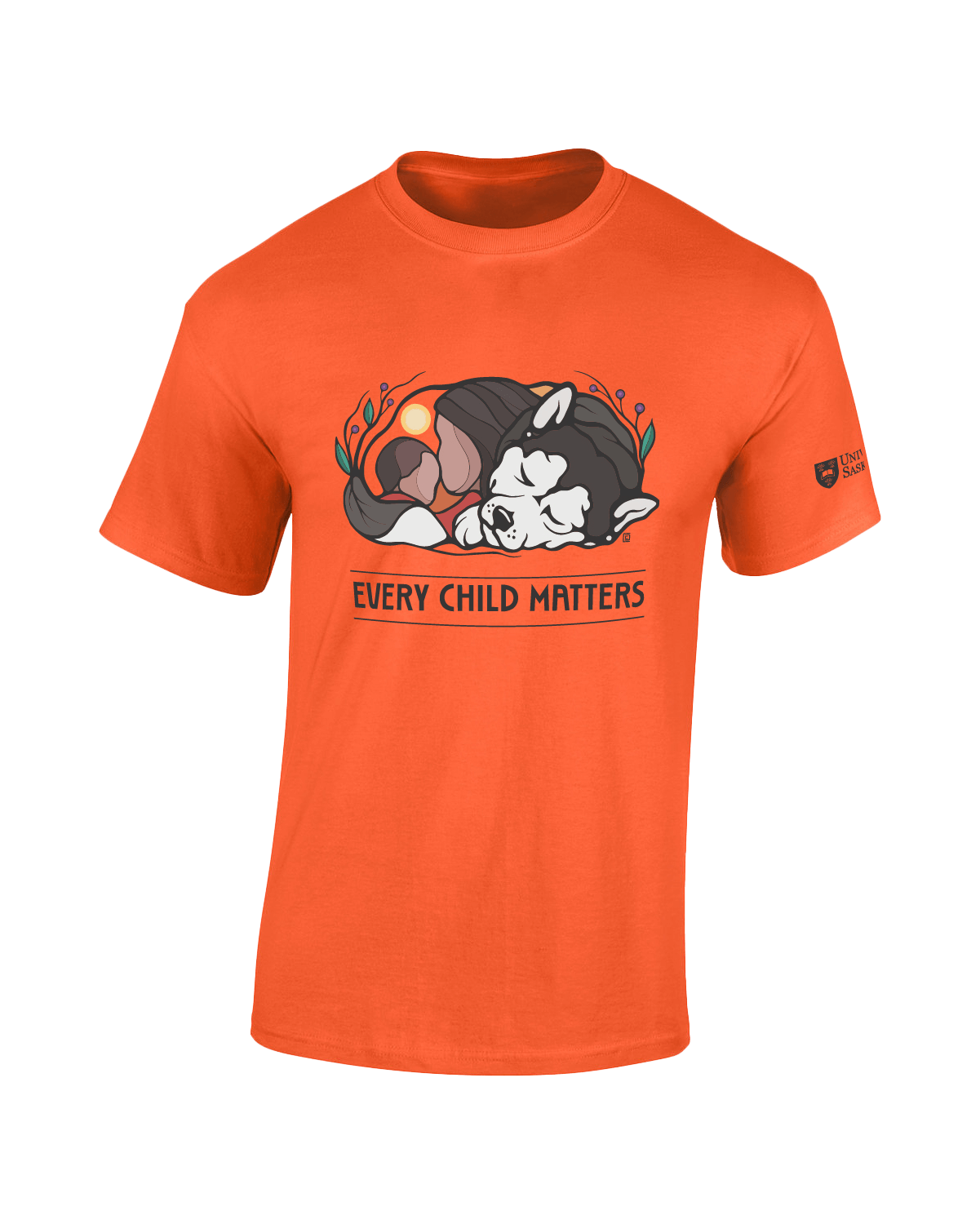
Honouring truth through art: Chris Chipak’s 2025 Orange Shirt Day design
The University of Saskatchewan (USask) continues its commitment to truth and reconciliation with a powerful new Orange Shirt Day design by Indigenous artist and educator Chris Chipak.
Observed annually on Sept. 30, Orange Shirt Day is a time for reflection, learning, and remembrance. It invites Canadians to confront the legacy of residential schools and engage in meaningful conversations about reconciliation. This year, USask is marking the day with a design that speaks to themes of family, protection, and cultural continuity — values that resonate deeply within Indigenous communities.
Chris Chipak, a member of Red Pheasant Cree Nation and a USask Bachelor of Education graduate, is known for his bold, story-driven artwork rooted in Indigenous teachings and Treaty 6 Territory. He previously collaborated with USask in 2023 to create a special rendition of the Huskie logo, incorporating Indigenous symbolism to support the university’s reconciliation efforts and honour Residential School Survivors.
His 2025 Orange Shirt Day design reflects a deliberate departure from the imagery often seen on orange shirts, such as handprints, florals, and butterflies. Instead, he chose to challenge himself artistically and focus on authenticity.
“I wanted this design to be different and more deeply rooted in our community,” said Chipak. “I also wanted to focus on being authentic and stay away from trends.”
At the heart of the design is a husky pup — a softer, more vulnerable interpretation of the familiar Huskie logo seen throughout the decades. “This added the visual of growth and nurturing,” Chipak said.
Surrounding the pup are elements that reflect Indigenous teachings, including the sun and Saskatoon berries. “The family ties and the connection of all living things are visually represented, all surrounded by the sun,” he said. “It allows viewers to see that we are all connected.”
The berries, he explained, “represent our territory and symbolize growth, resilience, and sustenance.”
Chipak’s personal journey also informs his work. “I struggled when I moved from Red Pheasant to Saskatoon,” he said. “It was a culture shock, and my art classes were the only reason I made it through my first couple of years at university.”
His early university experience played a pivotal role in shaping his artistic voice. While adjusting to life in Saskatoon, he found grounding and inspiration through his art classes at USask. One course in particular — focused on the Indigenous Group of Seven — became a turning point. This influential collective of Indigenous artists, active in the 1970s, challenged mainstream perceptions of Indigenous art and helped establish it as a vital part of Canada’s contemporary art scene. Their legacy sparked Chipak’s own journey into visual storytelling, encouraging him to explore themes of identity, resilience, and cultural continuity through his work.
He views each project as a meaningful step in his personal and professional journey. “I take every project as an opportunity to grow — for myself and the community involved,” he said. “I am very fortunate to have worked with the organizations I have, and from that, I have gained extended family.”
As both an artist and educator, Chipak sees visual storytelling as a powerful teaching tool. “When I teach a math concept like multiplication, I use different strategies to find the sum of two numbers, because we all learn differently,” he said. “In art, viewers need different ways to see the story you’re trying to convey, so revisiting your work — or using a new visual concept — allows that same process to occur.”
For young Indigenous artists, his advice is simple: “Be authentic, be a lifelong learner, share your stories, and always create.”
Chipak hopes the USask community — from first-year students to alumni — will find a personal connection to the design. “We were once all children,” he said. “I hope we all see it as a visual reminder that every child matters, and we are all connected.”

In 2019, the University of Saskatchewan (USask) Indigenous Space and Visual Symbols in the Health Sciences Committee began working with Shop USask to co-ordinate the sale of non-college-specific orange shirts to help the campus community recognize Orange Shirt Day on Sept. 30.
To date, orange shirt proceeds totalling over $49,000 have been directed toward a fund supporting the implementation of the Truth and Reconciliation Commission’s Calls to Action with a portion of proceeds also being directed toward the artist.
This year, shirts featuring a design by Chris Chipak will be available through Shop USask beginning Monday, July 14.
To order an orange shirt from Shop USask, visit https://shop.usask.ca/orange-shirt-day
- Group/department orders of 20 or more are eligible to receive a 10% discount and should be placed no later than Aug. 29 at noon to ensure arrival by Sept. 26.
Resources for learning and reflection
The University of Saskatchewan continues to advance its commitments to Truth and Reconciliation through ohpahotân | oohpaahotaan, the Indigenous strategy for the University of Saskatchewan. This strategy guides the institution in respectfully engaging with Indigenous worldviews, supporting decolonization, and uplifting Indigenization across all areas of university life.
The following resources are available to support learning, reflection, and continued engagement with the history and ongoing impacts of the Canadian residential school system, Orange Shirt Day, and the broader context of Truth and Reconciliation:
- Office of the Vice-Provost Indigenous Engagement (OVPIE)– Learn about Indigenization, decolonization, Indigenous wellness resources and cultural history: OVPIE website
- USask Spotlight– Visit spotlight.usask.ca for information on events and programming taking place on campus and in the community as Orange Shirt Day approaches. The site also features Indigenous wellness resources, community supports, and opportunities for continued learning and engagement
- I-Portal: Indigenous Studies Portal– Access a wide range of Indigenous-focused academic and cultural resources: I-Portal
- Summer reading list from OVPIE– Explore recommended books to support your learning journey: Summer reading list
- USask Orange Shirt Day research guide – Explore a curated collection of resources to support education, reflection and action:USask library guide
- Orange Shirt Day– Learn about the origins of this day through the story shared by Phyllis Webstad: orangeshirtday.org
- Office of the Treaty Commissioner: Reconciliation in Saskatchewan– Learn how individuals, communities and organizations across the province are advancing Truth and Reconciliation through local initiatives, partnerships and shared visioning:otc.ca
- Saskatoon Tribal Council– Learn about programs and services led by STC that support health, justice, education, family well-being, employment and community development in partnership with seven member First Nations: sktc.sk.ca
- Every Child Matters: Truth and Reconciliation– Access educational videos shared by the National Centre for Truth and Reconciliation: nctr.ca
- History of residential schools– Explore timelines and maps via Canadian Geographic and The Guardian:
- Video resources–
- Residential schools in Canada: A timeline (Historica Canada)
- Stolen children: Residential school survivors speak out (CBC News)
Health and wellness supports
- Indian Residential Schools Crisis Line– 24/7 support for survivors: 1-866-925-4419
- Hope for Wellness Help Line– 24/7 counselling for Indigenous peoples: 1-855-242-3310 or hopeforwellness.ca
- USask Student Affairs and Outreach– Support for students: 306-966-5757 or student.outreach@usask.ca

